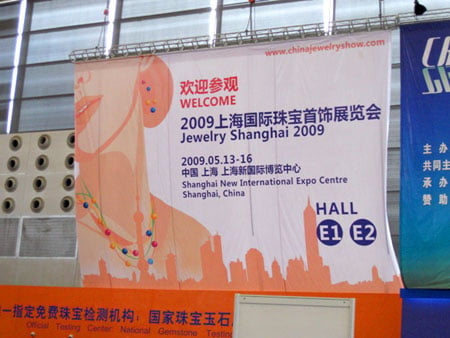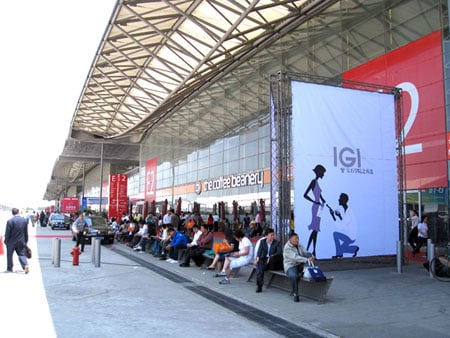How Are Diamonds Made? Natural vs Lab-Created Explained
Two Paths, One Diamond Not all diamonds come from the same place — but they all start the same way. Pure carbon, crystalized under immense pressure and heat. Whether it…

Mainland China’s incredible growth and potential is a melodious counterpoint to the songs of worldwide woe in our industry, as John Pollard discusses in the first of a two-part report.
China. The name evokes powerful images. Yet the west has little direct exposure to this millennia-old culture. News of growth and prosperity in this new century is bringing China recognition as an economic power; in fact, it is the United States’ biggest creditor. But their breathtaking culture and quickly rising economy are paired with a political regime slow to permit autonomy.
I took a personal interest in the development of the Chinese jewelry market after hearing Lawrence Ma speak at the 2006 GIA Symposium in San Diego. His description of their growing jewelry market was impressive at the time and all of the predictions he made have come true. The emerging statistics are startling; and not just in the jewelry sector. So when I was invited to speak at the International Gemological Institute seminar, as part of the 2009 “Jewellery Shanghai” show, I jumped at the opportunity to exchange information and report my experiences.
My session was titled “Your Clients of the Future and the Internet…Are You Ready?” and revolved around the way diamond shopping has reversed itself in the last decade: Consumers in the 1990s shopped in traditional stores first and looked on the Internet as a supplement, if at all. That has changed. Tomorrow’s consumers (aged 15-25) are wired into the Internet first and foremost. Shoppers are developing expectations based on what they read and view online, prior to ever setting foot in a traditional shop. I believe traditional jewelers must adapt their presentations, policies and staff education to compensate for this reversal if they hope to remain competitive. My talk offered strategies and solutions.
The lecture was well received. We had a full house and the audience was attentive for over two hours of discussion and storytelling. Each time a new page went up on the screen dozens of flash bulbs erupted and there was rapt note-taking. Afterwards the audience remained seated and I took questions via translator. Following the session, I received a line of individuals for private questions. After that, I was escorted to another area where I spent over an hour visiting with members of the Chinese media who attended the IGI event. From start to finish I was impressed with the intensity and investment in learning demonstrated by everyone: jewelry professionals, media and hosts.
With that said, I am certain that the impression I made on my generous audience couldn’t possibly have been stronger than the impact made on me.
A westerner’s first moments in China are awe-inspiring. The sense of enormity I felt was overwhelming and I’m no slouch when it comes to “big.” I’m from Dallas, after all. I cook massive steaks on big grills for big people at big parties. We drink 32-ounce bottomless cokes and supersize our fries. We maintain that “everything is bigger in Texas,” so I blithely presumed I had a black-belt in size. That was before visiting a city of 19 million souls. The scale was unimaginable. Skyline after skyline appeared as I was driven to my hotel. Office buildings, industrial centers, residences and urban areas passed by at high speed for an hour, seemingly with no end. Growth is everywhere and the sounds of industry are present 24 hours a day; a constant and tangible reminder of the country’s burgeoning economy.
China has a population of 1.3 billion people. Putting that number in context is difficult. Even Shanghai’s 19 million is hard to fathom. If New York and Los Angeles were smashed together into a single megalopolis it would not equal Shanghai’s population. That single city has more people than many countries and is only 2 million shy of the entire continent of Australia. As unimaginable as that is, Shanghai doesn’t boast the largest metropolitan area in China. That distinction goes to Chongqing with an administrative population of 32 million! (2009 UN Dept of Economic and Social Affairs estimates.)
As China absorbs western culture, a trend that has steadily escalated is their diamond engagement tradition. May’s “Golden Week” has historically been a popular time for weddings. In 2006, there were more than 30,000 weddings in Shanghai alone during Golden Week. In 2007, that number exploded to 100,000 (in one city, in one week)! As a result, Shanghai made the decision to reduce the “week” to a three-day holiday. The engagement tradition continues to grow, with May and October celebrations in Shanghai seeing more than 50,000 weddings annually.
Sales in the diamond and jewelry sector are growing along with China’s interest in the engagement tradition. De Beers reported that diamond sales in mainland China grew by over 15 percent from October 2008 through the first quarter of 2009. With declines in major markets such as the U.S., Europe and Japan due to the economic downturn this makes China, along with India, the only markets worldwide to maintain growth in diamond sales. Sun Wensheng, chairman of the Gems & Jewelry Trade Association of China, reported gross sales increasing by over 10 percent last year, reaching 180 billion Yuan ($24 billion). Experts at the Shanghai Show predicted that China’s jewelry industry should expect annual sales of 300 billion Yuan ($39 billion) and exports of over $12 billion by 2020. China is currently the world’s largest consumer of platinum, the second largest consumer of diamonds and the third largest consumer of gold. As the diamond engagement tradition continues to gain momentum, some experts say the predictions above may be conservative.

It is no secret that western middle class earners are ahead of their Chinese peers. For example, 25 percent of all U.S. households made $75,000 or more in 2005 (U.S. Census Bureau figure). The number of comparable households in China today is about 3 percent. But statistics don’t tell the whole story when compared to actual numbers: With 1.3 billion people in China one must multiply any percentage by a factor of four to compare with the U.S. Simply put, when only 6 percent of Chinese households earn $75,000 or more their country will equal the U.S. in terms of luxury spending power at a certain basic level. Upon reaching 12 percent China will double the U.S. in that ability. Logically, while luxury spending in China is not the equivalent of such spending in the west right now, it’s possible that any unified decision by the growing middle class to influence or control a given market could be realized once the numbers are achieved. It’s a matter of mathematics.
Two hundred and sixty four million people use the Internet in China today. Here is something worth thinking about. The total population of the U.S. is 304 million. If we presume 90 percent of the U.S. can access the Internet it means we’re about even today, and the U.S. has nearly reached saturation. But more than 1 billion people in China do not yet have access. As their economy gains momentum the number of Chinese coming online and influencing global e-commerce may easily wind up doubling or tripling the entire U.S. population.
Eight percent of total jewelry sales in 2008 were done online in China for about 1 billion Yuan ($150 million). In keeping with the above, that figure is expected to double in 2009. This is because China’s internet community spends relatively little on jewelry at this time: Where the US population spent $3 billion online for jewelry last year the Chinese web community (nearly as large as the U.S. population) spent only one twentieth of that sum. This leaves room for incredible growth, making bold predictions logical.
The implications are even more formidable when one remembers that this is only the leading edge. The number of people using the web in China could double or triple the U.S. population in coming years and their spending power is growing. As more users come online and become comfortable spending the potential for growth in online sales in China (not just jewelry) might surpass anything the world currently knows.
With that statement made, there are differences in the current Chinese online buying model that could limit the velocity of escalation for online diamond and jewelry purchases: In America shoppers find elaborate online “biographies” for each loose diamond offered by primary internet sources. Blue Nile, the market leader, provides a scanned grading report and magnified photo of the actual diamond at the minimum. More cut-focused sellers also include that diamond’s image taken in Ideal-Scope® or ASET® (scientific tools to demonstrate light return quality), “hearts & arrows” photos and even a 3D scan which the most technical-minded consumers can open and evaluate in freeware. This abundant presentation, along with refund assurances and guarantees, make a consistent percentage of western buyers comfortable enough to complete their transaction online, without seeing the diamond live beforehand.

Chinese buyers, on the whole, are not yet ready to make the leap to buying-without-seeing. Few people complete transactions from afar. Instead, online shoppers identify diamonds they would like to see from basic lists (sometimes with a posted grading report), but the actual purchase is made at an “experience store” where the client views diamonds he has selected from a list and makes a live selection.
Many consumers in America read internet discussion forums to get diamond-buying advice. Pricescope.com, Diamond Chit-Chat and Diamond Review are popular U.S. sites, with Pricescope the runaway leader, attracting over 350,000 unique visitors per month. Meanwhile there are thousands of consumer discussion boards in China, serving the growing internet population in their own language. While some Chinese participate on western websites the online Chinese market has grown in a largely self-contained manner, and it lacks the depth of the American market. The cyber-purchasing phenomenon in China will continue to grow, but fundamental differences in the online diamond buying process will limit the number of sight-unseen purchases. ■
by John Pollard, US Account Executive
Infinity Diamonds
* First published in IDEX Magazine, November 2009 – Reproduced with author’s permission
Click here to discuss on the Forum